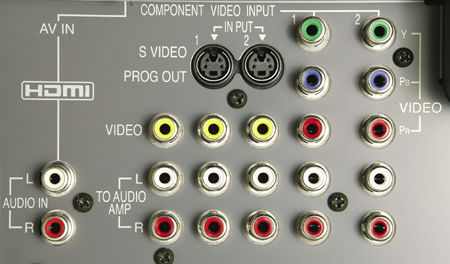Panasonic PT-AE700U LCD projector Page 2
The PT-AE700U delivered a mixed bag of results. Over the past year or so, I've noticed a steady decline in the performance of composite-video decoding in many front projectors; Panasonic appears to have given up on it as well. Using the Zone Plate from the Video Essentials test DVD, I couldn't see any image detail above 300 lines, and the moving target was loaded with cross-color artifacts.
Panasonic used to include outstanding composite-video processing in all of their display products, so this mediocre performance came as a bit of a surprise. Perhaps they've determined that with so many progressive-scan DVD players using Faroudja processing these days, it doesn't make sense to spend the extra dollars to incorporate what might be a redundant circuit that will get little use.
 While I can live with that thinking, I was disappointed in the quality of deinterlacing and motion correction through the PT-AE700U's S-video and component inputs. Both the waving-flag sequence from VE and the racecar and spinning-bar test pattern from the Silicon Optix benchmark DVD revealed lots of scan-line artifacts. The PT-AE700U was also slow to pick up on transitions from video to 3:2 film-to-video cadences.
While I can live with that thinking, I was disappointed in the quality of deinterlacing and motion correction through the PT-AE700U's S-video and component inputs. Both the waving-flag sequence from VE and the racecar and spinning-bar test pattern from the Silicon Optix benchmark DVD revealed lots of scan-line artifacts. The PT-AE700U was also slow to pick up on transitions from video to 3:2 film-to-video cadences.
Unless the review model I tested had some problems I didn't know about, I'd advise you to use a quality DVD player with this projector and handle all of the 480i signal processing outboard, including 3:2 pulldown and motion-adaptive correction. Playing back the same DVD sequences through my Panasonic RP56 DVD player in 480p mode cleaned up all the problems listed above.
Content sent to the projector at 480p was far more impressive, particularly films with lots of low lighting and deep shadows, such as Men In Black and Pirates of the Caribbean. I had not seen an LCD projector ever look this good before with deep shadows, so I dusted off my copy of The Fifth Element to provide another low-light challenge.
No matter—the PT-AE700U was quite capable of rendering nice, rich blacks and low shades of gray with every movie. Mind you, that doesn't mean I saw all of the detail in each individual DVD's low-level scenes—LCD technology still has limits on how low it can go (about 10% gray seems to be the lower limit). But the auto-iris circuit worked like a champ, at times giving the impression that I was watching a good DLP or even a CRT projector.
Black levels are one thing, and color is another, and here's where the PT-AE700U really shone. I spent a lot of time playing with the white-balance and color-saturation controls to get as close a match as possible to my reference Princeton AF3.0HD CRT monitor; the Panasonic came closer than any other front LCD or DLP model I've tested.
The excessive blue-green spectral output from short-arc projection lamps makes it difficult to render pastel shades cleanly, particularly subtle shades of red, orange, and yellow. While the red, green, and blue color coordinates are still offset from the SMPTE C standard, I was quite pleased at how well flesh tones and pastel color shades matched up between the Panasonic and the Princeton.
The difference was a slight but noticeable magenta cast from the projector that I just couldn't tune out completely. It was much more noticeable with black-and-white images than with color images, and most of the time you won't see it. I'd like to see Panasonic apply more of their color magic to completely clean up the gray scale on the PT-AE700U.
I saw the best-looking images with 720p and 1080i content. Even though the projector doesn't have quite enough bandwidth for maximum HD resolution (it rolls off above 18MHz), the mix of films and live content I watched had plenty of contrast and good color rendering. Interestingly, 1080i video sources didn't have nearly as many scan-line and motion artifacts as I saw with 480i material.
The auto-iris circuit really worked; in my tests, black levels were an average of 50% lower with it switched on. I'd advise you to leave it turned on all the time. Remember that the human eye can't handle much more than a 100:1 contrast ratio at any given instant; the PT-AE700U takes advantage of that by constantly sliding the picture dynamic range up and down from scene to scene.
Conclusions
I had mixed feelings about the Panasonic PT-AE700U. On the one hand, it delivered really nice color, the highest contrast, and the lowest black levels I've ever seen from an LCD projector. On the other hand, its 480i performance was mediocre at best, which means you'll need to use a good progressive-scan DVD player and/or outboard video scaler to make the PT-AE700U shine.
But that auto-iris circuit is really effective, and the optical system softens the screen-door effect just enough that it's not apparent, although overall image quality is a tad softer as well. (You can't get something for nothing.) With all those bells and whistles, the extended color-management system, and a retail price just under $3000, this projector has enough going for it that it's worth a serious look for your theater.
Ups and Downs
Up
• Smooth picture with minimum screen door effect
• Bright image
Down
•Smooth Image feature slightly reduces detail
•Mediocre scaling of 480i sources; use with a good progressive scan DVD player























































